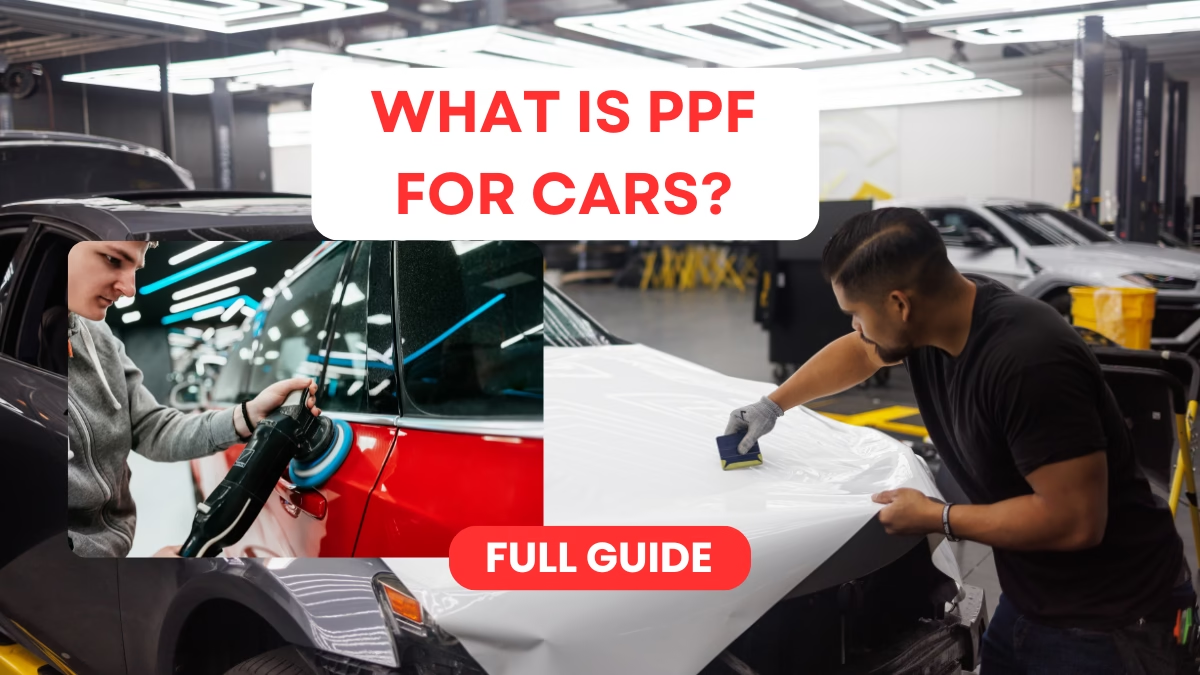Installation Process of PPF

Professional vs. DIY Installation
When it comes to PPF installation, you have two options: hiring a professional or doing it yourself. Professionals have the tools, experience, and clean environments necessary to ensure a flawless application. DIY kits are tempting for budget-conscious car owners, but they often lack the precision required for a seamless finish. A professional installation may cost more upfront, but it prevents costly mistakes.
Steps Involved in Installing PPF
Here’s what happens during a professional PPF installation:
- Surface Preparation: The car is thoroughly cleaned to remove dirt, grease, or wax. This ensures the film adheres properly.
- Custom Cutting: Using advanced software, the PPF is precisely cut to match your car’s make and model.
- Application: A special solution is applied to the car and the film for easy positioning. Once aligned, the installer uses squeegees to remove air bubbles and secure the film.
- Final Inspection: The film is checked for any imperfections and adjusted as needed.
How Long Does PPF Last?

Average Lifespan of PPF
On average, high-quality PPF can last anywhere from 5 to 10 years. Factors like the brand, maintenance routine, and environmental conditions can influence its longevity. Premium films often come with warranties that cover several years of performance.
Maintenance Tips to Extend Durability
To get the most out of your PPF, follow these tips:
- Wash Gently: Use a pH-balanced car shampoo and a soft microfiber cloth to avoid scratching the film.
- Avoid Harsh Chemicals: Products containing alcohol or solvents can degrade the film’s integrity.
- Inspect Regularly: Check for any peeling or damage and address issues promptly to prevent them from worsening.
Cost of PPF Installation

Factors Influencing the Price
The cost of PPF installation varies widely based on several factors:
- Car Size: Larger vehicles require more material, driving up the cost.
- Coverage Area: Full-body PPF costs more than protecting specific sections like the hood or bumpers.
- Film Quality: Premium brands with advanced features like self-healing or UV resistance are pricier.
- Labor Costs: Professional installers charge based on their expertise and location.
Comparing Costs with Alternative Protection Methods
Here’s a quick cost comparison:
| Protection Method | Estimated Cost | Lifespan | Maintenance Requirements |
|---|---|---|---|
| PPF (Full Body) | $2,000–$7,000 | 5–10 years | Low (Regular cleaning) |
| Ceramic Coating | $1,000–$2,500 | 2–5 years | Medium (Reapplications) |
| Waxing | $50–$150 | 1–3 months | High (Frequent reapplications) |
While PPF is the most expensive upfront, it offers long-term savings by reducing paint repair costs.
Common Mistakes to Avoid with PPF
Neglecting Proper Maintenance
Ignoring upkeep can shorten the lifespan of your PPF. Regular washing, avoiding harsh chemicals, and parking in shaded areas can make a significant difference.
Choosing the Wrong Installer
Not all PPF installers are created equal. Choosing an inexperienced installer may result in bubbles, peeling, or uneven coverage. Always check reviews and ask for certifications before hiring someone.
PPF vs. Ceramic Coating
Key Differences
While both PPF and ceramic coatings protect your car, they serve different purposes:
- PPF: Primarily shields against physical damage like scratches and chips.
- Ceramic Coating: Creates a hydrophobic layer that repels water, dirt, and UV rays.
Can They Be Used Together?
Yes, PPF and ceramic coatings can complement each other beautifully. Apply PPF first to protect against physical damage, then layer ceramic coating on top for added shine and easier cleaning.
Environmental Impact of PPF
Is PPF Eco-Friendly?
Most PPF products are made from durable plastics, which aren’t biodegradable. However, many manufacturers are adopting greener practices by using recyclable materials and non-toxic adhesives.
Disposal Considerations
When replacing PPF, ensure the old film is disposed of responsibly. Some installers offer recycling programs or eco-friendly removal options.
Myths About Paint Protection Film
Common Myths
- PPF Turns Yellow Over Time: Modern films are UV-resistant and won’t discolor like older versions.
- PPF Is Only for New Cars: PPF can protect both new and older vehicles, as long as the paint is in good condition.
Science Behind PPF
The multi-layered construction of PPF combines elasticity and strength. It’s not just a fancy sticker—it’s a carefully engineered product designed to withstand real-world conditions.
Popular Brands of PPF for Cars
Industry-Leading PPF Manufacturers
Some top brands include:
- XPEL: Known for self-healing properties and a variety of finishes.
- SunTek: Offers advanced UV resistance and excellent clarity.
- 3M: A trusted name with innovative PPF solutions.
Features to Look For in a PPF Brand
When choosing a brand, prioritize:
- Thickness
- Self-healing capabilities
- Warranty
Choose the Best PPF for Your Car
Tips for Selecting the Right Film
Consider your specific needs, such as climate, driving habits, and aesthetic preferences. If you live in a sunny region, opt for UV-resistant film. For rough terrains, choose a thicker option for added durability.
Factors Like Climate and Usage
PPF performs differently based on environmental factors. For example, high humidity can affect adhesive performance during installation, making professional application even more crucial.
Conclusion
PPF is an investment in your car’s long-term beauty and functionality. It protects against everyday wear and tear, boosts resale value, and keeps your car looking like new. With proper care and installation, it’s a decision you won’t regret.
FAQs
Is PPF worth the investment?
Absolutely. It provides unparalleled protection against scratches, chips, and UV rays, saving you money on paint repairs in the long run.
Can I remove PPF after installation?
Yes, PPF can be removed safely by professionals without damaging your car’s paint.
Does PPF affect the car’s paint?
No, as long as it’s installed and removed correctly. In fact, it helps preserve the paint.
What happens if PPF gets damaged?
Minor damages like scratches can heal with heat in self-healing PPF. For severe damage, individual sections can be replaced.
How often should PPF be replaced?
PPF typically lasts 5–10 years, depending on quality and maintenance. Replace it when signs of wear appear.

